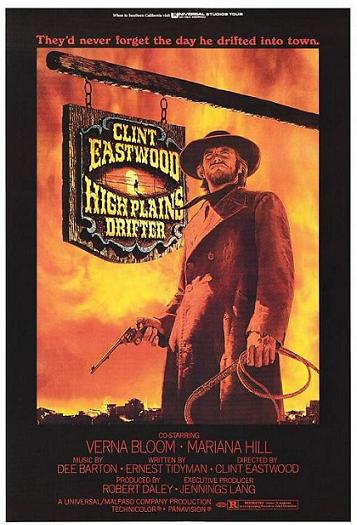
John Wayne is most often seen as the king of westerns, but for my money, nobody has made more interesting contributions to the genre than Clint Eastwood.
Throughout the '60s and '70s, Eastwood made his mark by playing the same basic type of character -- a hard man of few words with steely eyes, muddy morality and gunslinging skills that could break anyone. But what makes Eastwood's westerns interesting is he approaches that character from numerous angles, constructing wholly different men from the same template.
In Sergio Leone's Dollars Trilogy, The Man With No Name is someone who will bend the rules and occasionally use people to get ahead, but at heart he is also a man who will help those who truly need it. In Unforgiven, he is an over the hill cowboy struggling to sever ties with his bloody, evil past. In High Plains Drifter, Eastwood's Stranger has goals of a sort beyond the ability of good people to understand.
High Plains Drifter opens with The Stranger (Eastwood) seemingly materializing out of thin air as he rides his horse on a short trip through the town of Lago. Everyone watches as he makes his way through; nobody can keep their eyes off him. Three gunslingers hired by the town to protect them from three criminals who are to be released from the Yuma Territorial Prison accost The Stranger. He responds by brutally killing them.
With the town's protection gone, Lago's sheriff (Walter Barnes) pleads with The Stranger to help protect Lago. The Stranger initially refuses but relents when Lago's citizens allow him free reign through the town. He then trains the townspeople in the art of killing, turns the town's power structure upside down and makes a series of bizarre requests, all the while fulfilling his mysterious agenda while the three released convicts make their way back to Lago to seek vengeance.
What makes The Stranger interesting, first of all, is he is possibly the most hateful character Eastwood has ever played, and yet there are definite reasons why he does what he does. He is a killer; he is a rapist; and he milks Lago for all it is worth. However, the movie's ending puts these actions into perspective -- it does not make them right, by any means, but it does provide a clear reasoning for The Stranger's atrocities.
However, while the thoughts behind The Stranger's actions, can be understood, the man himself is more like a demon than a human. The movie plays off this in several ways. During one scene, The Stranger is attacked while bathing, and he sinks into the water to avoid gunshots. The shots clearly go into the water, but after the attack, The Stranger floats to the surface, unscathed. A normal human would surely have died in that attack. In other scenes, The Stranger moves through his environment like a wraith, appearing in places nobody expects.
The movie's mood also reinforces The Stranger's demon-like nature. High Plains Drifter is mainly a western, but in a very subtle way it is also part horror. The most obvious occurrence of this is in the musical cues. There are occasional flashbacks, and these are accompanied by a dreamy, cutting synthesizer bit that heightens the tension and violence of the scene. This same cue is used in some of the more violent parts of the movie and also during the movie's penultimate sequence, which is legitimately terrifying.
One other thing that fascinated me is how Eastwood, as the movie's director, uses some classic types of western shots to further boost the feeling of horror and dread. There is of course the movie's initial shot of The Stranger appearing like a mirage in the middle of the desert. Western heroes often walk alone across barren, heated landscapes, but the way the shot is set up makes The Stranger seem distinctly ghost-like. The first time the viewer sees Lago is also vaguely unsettling. Eastwood has the shot far away, which shows Lago as a collection of random buildings in the middle of nowhere, a pit of nothing that is almost trying to bury itself away from civilization. Like the rest of the movie, it is an interesting, subtle subversion of how most people see westerns.
High Plains Drifter is an excellent part of the Revisionist Western movement that started with movies like High Noon and Shane in the '50s and continues sporadically to this day. For those who tired quickly of the traditional, black-and-white western morality tales, High Plains Drifter is worth watching to see the genre's potential.
Now here's a new feature I am adding to this World. At the end of the movie posts, I'll add scenes from the movies so that people can watch them and perhaps pique their interest. I will be going back to all the other posts in this World and adding scenes where I can.
This scene from High Plains Drifter shows The Stranger being harassed by the gunslingers hired by Lago and the consequences of their actions.